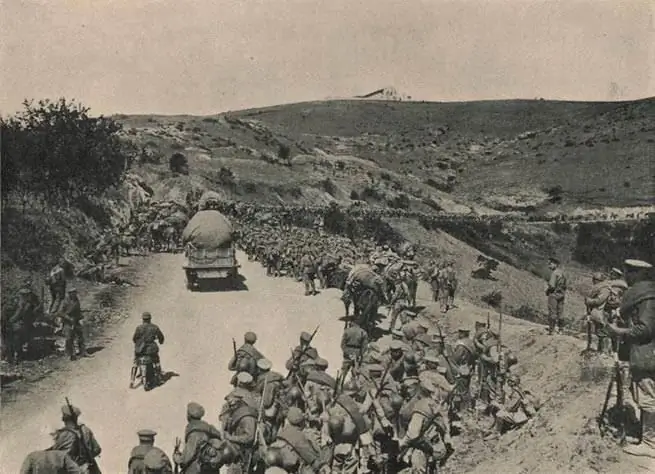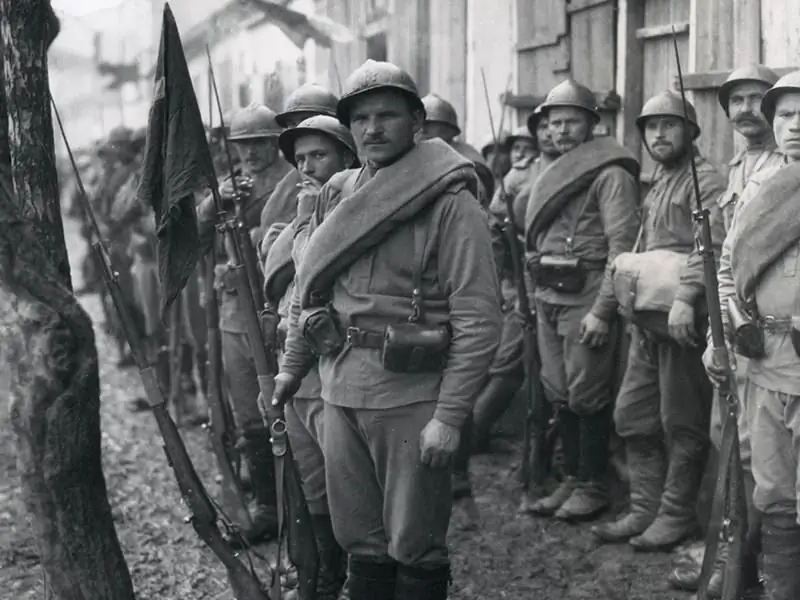- Author Matthew Elmers [email protected].
- Public 2023-12-16 21:49.
- Last modified 2025-01-24 09:17.
Thessaloniki front. Forgotten page of the First World War.
Motley front
Whoever was on the forgotten Salonika front of the First World War! French, British, Serbs, Italians, Greeks, Algerians, Moroccans, Senegalese, Macedonians, and in August 1916 the Russians were added to them. On the other side of the front, Germans, Austrians, Bulgarians, Turks, Arabs and Czechs fought with them. At the same time, there was serious tension between almost all local peoples, which John Reed very accurately described in his memoirs about the Thessaloniki front:
"A characteristic feature of local residents was their hatred of the closest neighbors of other nationalities."
Such an ethnic salad was abundantly flavored with the intractability of the commanders. Thus, Major General Mikhail Dieterichs, mentioned in the previous part of the cycle, categorically refused to come under the leadership of the Serbs, motivating this with the following: "It is inconvenient to include the troops of such a great power as Russia in the army of a small state." It turned out to be much more convenient to be a Russian Special Brigade under the leadership of French officers. They did not particularly stand on ceremony with the Russian units entrusted to them and, without even waiting for concentration upon arrival, immediately threw them into battle. The idea of the Russian offensive belonged to the French front commander, General Maurice Paul Emmanuel Sarrail, and he carried it out on September 12, 1916. On this day, the Russian regiments went to the Kaymakchalan heights, which were under the control of the Bulgarian divisions. The resistance of the Bulgarians was worthy - they did not make any allowances to the soldiers of the fraternal Russian people. For example, one of the regiments of the 2nd Special Russian brigade on September 24 in battles with the Bulgarians lost about a third of its personnel wounded and killed. Many Bulgarian officers received military education in Russia, and the uniforms largely copied the Russian uniform, which often confused the attacking soldiers of the imperial army.

General Maurice Paul Emmanuelle Sarrail
The attitude of the French towards the Russian units on the Thessaloniki front was ambiguous. On the one hand, due to heavy losses, the brigade was awarded the "Military Cross with a Palm Branch" on the banner. On the other hand, a special Franco-Russian division was assembled, in which there were no ethnic Frenchmen - they were replaced by Annamites and Zouaves from the colonies, which, naturally, no one spared on the battlefield. As well as Russian soldiers.
Russian annamits
October 1916 was marked for the Russian forces on the Thessaloniki front with heavy losses from the incompetent French command. The division, assembled from the natives of Africa and Russian soldiers, was treated with disdain, thrown into the most hopeless sectors of the front. In early October, the division several times unsuccessfully tried to break through the defenses of the Bulgarians, suffered significant losses, but each time failed. Sarrail did not bother to support the attacks of heavy artillery (the Russians did not have their own), to which General Dieterichs even sent a protest to Paris and Petrograd. The French did not try to supply the Russians with the necessary equipment and weapons, as a result, our units were equipped at the level of the colonial troops.
Selfless attacks with considerable losses were nevertheless crowned with success, and on October 19, 1916, the division reached the city of Manastir, which the Bulgarians had previously recaptured from the Serbs. Now it is the Macedonian city of Bitole, and in it you can find a monument to the French troops who died here. The Russians are mentioned only 40 km from this place in the town of Prilep - a memorial sign appeared here only in 2014.

French "Military cross with a palm branch"
The 2nd Special Brigade was not the only Russian on the Salonika front. In October 1916, another unit arrived - the 4th Special Infantry Brigade, assembled from the soldiers of the reserve regiments. The total number of Russian soldiers who fought on the Greco-Macedonian border reaches 20 thousand, and taking into account the constant replenishment and all 30 thousand. Being under the command of the French, Russian soldiers and officers nevertheless quickly found a common language with the black natives of Africa than with selfish and arrogant Europeans.
It is worth citing an episode of the massacre in which the Russian expeditionary units fell on the Thessaloniki front. The 2nd Special Brigade lost about 1000 people killed and wounded during the attack of the entrenched Bulgarians at the bend of the Cherna River. The results of the bloody battle were immediately devalued - without the support of the allied troops, the Kaiser's soldiers drove the Russians from the captured height. This battle among the Bulgarians later went down in history under the somewhat paradoxical name of "Macedonian Shipka".
The tension builds up
1917 year. The king is overthrown. In the summer, artillerymen and sappers were sent from Russia to the aid of the compatriots who had settled on the Thessaloniki front, who reached their destination only by October. This replenishment was already imbued with an anti-war spirit, the French seemed to feel something and greeted the Russians without flowers and applause. The mood became more and more painful every day - the Russians realized that they had exchanged their lives for shells and equipment of their allies. In addition, relations with the French were aggravated, who saw fermentation in the Russian army and accused the soldiers of a lack of initiative on the battlefield, and sometimes of outright cowardice. The murder of warrant officer Victor Millo by the French brought the Russian brigades to the brink of an armed revolt. The perpetrators of the crime were never found. It was very hard for the Russian wounded, whom the French placed in barracks with German prisoners of war, equating the status of allied soldiers with the enemy. There were only a few Russian-speaking doctors, and sometimes for a long time they could not make basic diagnoses and prescribe treatment for the wounded.

The first to leave for Russia and soon joined the White movement was General Dieterkhis. Russian units that refuse to fight, in fact, found themselves without command. The French, fearing trouble, transferred the Special Division, formed from two brigades, to the mountain range on the border with Albania, and blocked them from the rear with barrage Franco-Moroccan detachments. The new conditions were very difficult - a chronic shortage of water (two glasses a day per person), hellish cold and impenetrable mountainous terrain. In the early autumn of 1917, a decision was made in Petrograd to return soldiers from abroad to their homeland. However, France ignored Russia's decision.
Enslavement
In fact, by the end of 1917, the Russian special division was captured by the French, who were angry with the new Petrograd government for peace negotiations with the Germans. France, represented by General Sarrail, proposed to divide the Russians into three categories: those who want to fight, who refuse to fight and who do not obey the French administration. The first went back to the front, the second were sent to special "workers' companies", in the last, the most dangerous, they were sent to hard labor in the French colonies of Africa. In December, under a deceptive pretext, Russian units were disarmed, disbanded in different parts of Greece, which later became camps for our compatriots. Former Russian allies became prisoners of war for the French, whom they seemed to have forgotten about in their homeland, and with whom you can now do whatever you want. The most implacable soldiers and officers were demonstratively shot, chopped with sabers for fun, starved to death … By the summer of 1918, everything was decided with the Russians on the Thessaloniki front: 1014 fighters returned to France as volunteers, 1195 went to the Foreign Legion, 15 thousand were equipped in “workers' companies ", And about 4 thousand of the most desperate were sent to African hard labor.

Hunger, a 15-hour working day, appalling living conditions - all this awaited the Russian soldiers who fell into the French "workers' companies". Only Serbs expressed some sympathy and even once forcibly rescued 600 Russians from the camp. In response, the French command forbade the Russians to join the Serbian army.
The exact numbers of those who died in such conditions are still unknown: obviously, such data for France is not at all a reason for pride.
It soon turned out that the Russians had not been forgotten at home, and even at the beginning of 1920 they had captured a large "party" of French and Belgian prisoners. The Bolsheviks offered to exchange this living commodity for the remnants of the unfortunate compatriots from the Thessaloniki front. To the shame of freedom-loving France, the Russians managed to negotiate an exchange in the ratio of 1 "precious" Frenchman for 25 Russian soldiers. As a result, the last Russian prisoners were able to return to Russia only at the end of 1923. Until this time, most of the soldiers were in a slave position in La Belle France.






